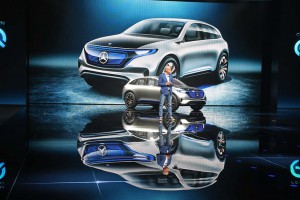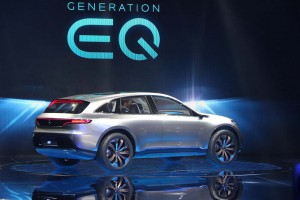Anyone who thinks battery power is just for a select niche of techies and greenies might come away with a very different opinion after touring this year’s Paris Motor Show. And if the message still doesn’t come across, just ask Daimler AG Chairman and CEO Dieter Zetsche, who assured a media audience that the Mercedes-Benz brand is moving electric vehicles “into the fast lane.”
The automaker previously committed to putting 10 plug-in hybrids and several pure battery-electric models into production over the next several years. But the Mercedes Generation EQ concept making its debut at the Mondial de l’Automobile takes things a step further. It will launch an all-new electrified brand, dubbed EQ, to challenge the likes of America’s Tesla and arch-rival BMW’s “i” brand. Future products will be badged “Mercedes-EQ, Zetsche told TheDetroitBureau.com
“The emission-free automobile is the future,” said Zetsche. “And our new EQ brand goes far beyond electric vehicles. EQ stands for a comprehensive ecosystem of services, technologies and innovations.”
Unlike many of the Mercedes brand’s recent show cars, the EQ is relatively conventional in exterior design – though it’s another matter inside. That underscores the fact that the technology is moving into the mainstream.
Going forward, Mercedes will focus on four pillars, according to the CEO, “connected, autonomous, shared and electric.” That makes a “CASE” for a number of trends reshaping the global industry, all captured within the Generation EQ concept.
Mercedes is forecasting that tomorrow’s cars will be connected not just to the Internet but to each other. That, in turn, will make it easier to bring autonomous and even driverless technology to market. Car and ride-sharing are expected to become more commonplace – and Daimler has been heavily investing in both services. Meanwhile, electric propulsion is expected by many to give the conventional internal combustion engine a serious run for the money over the next decade.
On the technical side, Generation EQ follows a path being blazed by a number of other automakers. Rather than trying to adapt an existing gas or diesel model to use battery power, it rides on a dedicated platform that optimizes the positioning of batteries, motors and electrical componentry. As a result, a relatively modest-sized vehicle can offer significantly more interior and cargo space than today’s models.
According to a statement by Mercedes, “The new generation of electric vehicles will be based on an architecture developed specifically for battery-electric models, which is scalable in every respect and usable across all models.”
That means everything from small to large, as well as sedans, coupes, convertibles, even SUVs and crossovers and “other model series.”
The basic design of Generation EQ is intended to blend a coupe with a crossover, according to Mercedes design chief Gorden Wagener. Calling the concept both “hot and cool,” he added that it is a “reinterpretation of our design philosophy…the idea being to create an avant-garde, contemporary and distinctive electro look.”
(Live from Paris, Click Here for complete coverage of the 2016 Mondial de l’Automobile.)
Under the skin the Generation EQ – and future production models – uses a lightweight, multi-material mix of steel, aluminum and even carbon fiber. Automakers across the globe are racing to lightweight their vehicles, and composites are one of the Holy Grails. Rival BMW has gone so far as to set up the world’s largest carbon fiber factory in Washington State to supply its electric vehicle sub-brand.
Inside, the Generation EQ isn’t quite as radical as some recent Mercedes concepts, such as the F 016, but still pushes boundaries in terms of both electronic technologies and its user interface. That includes a floating 24-inch OLED widescreen display and a more tablet-like control system than is found in today’s Mercedes vehicles. Forget the rotary controllers and knobs.
Drivers can make significant changes to the display, including colors and layout, meanwhile.
In terms of the drivetrain, the Generation EQ features electric all-wheel-drive and puts out a total of 402 horsepower and 516 pound-feet of torque. That’s enough to launch the concept vehicle from 0 to 60 in “under five seconds.”
(Click Here for details about Audi’s Paris unveilings.)
Meanwhile, Mercedes claims the lithium-ion battery pack will allow motorists to travel about 325 miles between charges. The maker is vague about that pack but suggests it will be over 70 kilowatt-hours. Meanwhile, with new Level 4 charging systems of up to 300 kW under development, the maker claims it may soon be possible to get a near-complete recharge in as little as five minutes.
Generation X, no surprise, boasts a variety of advanced safety systems, as well as autonomous capability. Mercedes has been a long and avid proponent of self-driving systems and hopes to have its first hands-free model on the road early in the new decade.
To get to that point, the EQ not only features a “sensor fusion” of technologies like laser, radar and cameras, but also boast Car-to-X systems that can connect with other vehicles, as well as a highway infrastructure. It also uses the highly detailed, 3D maps from HERE, the mapping company recently sold by Nokia to a consortium of German carmakers.
As for production? The Generation EQ is, at the moment, just a concept, but it is clear that the four pillars it stands on will wind up in a variety of road-going models in the relatively near future. Look for the first production model, largely based on the Paris show car, to reach showrooms within three years, Zetsche said during a conversation after the Mercedes news conference. Expect it to be priced around the same as a “well-equipped GLC” crossover, he also noted.
(Lexus downsizes with UX sport-ute concept. Click Here to check it out.)
Mercedes won’t be able to wait. Its competitors have a similar vision. Volkswagen, for example, revealed its long-range I.D. battery car in Paris and said that, along with sibling brands like Audi and Porsche, it expects to be selling 1 million or more pure battery-electric models annually by 2025.


